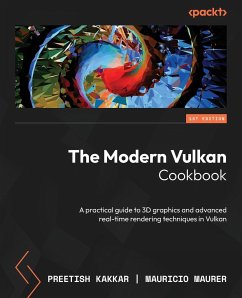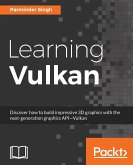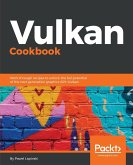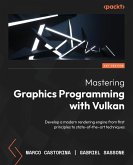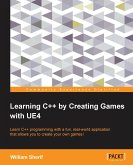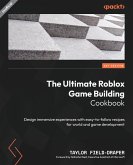Discover essential real-time rendering techniques, curated by industry-leading computer graphics professionals, with over 60 recipes for extending or applying them directly to existing or new rendering engines focusing on Vulkan Key Features - Explore a wide range of advanced 3D graphics programming techniques to leverage the full potential of Vulkan API - Learn tips, tricks, and solutions to boost your 3D graphics for a wide range of cross-platform devices - Implement geometry projection, texturing, and lighting techniques - Purchase of the print or Kindle book includes a free PDF eBook Book Description Vulkan is a graphics API that gives the program total control of the GPU, allowing the GPU to be used to its full potential. This cookbook will uncover useful techniques for emerging new technologies, such as hybrid rendering, extended reality - mixed reality (MR), augmented reality (AR), virtual reality (VR) - and GPU-driven rendering, and even features a dedicated chapter to help you debug and profile your graphics applications with tips and tricks tested in real-world scenarios. The book starts by explaining basic Vulkan concepts while guiding you through the implementation of a basic graphics engine. The building blocks presented in the first few chapters will then help you implement more advanced techniques and algorithms, while getting you acquainted with the inner workings of Vulkan. Gradually, you'll discover how Vulkan can be used to build hybrid renderers as well as leveraged for the future of graphics with AR/VR/MR. Moreover, you'll gain an understanding of how it can be debugged or measured for performance. By the end of this book, you'll be well versed in how to use Vulkan to write graphics applications and how graphics algorithms are implemented using Vulkan. What you will learn - Set up your environment for Vulkan development - Understand how to draw graphics primitives using Vulkan - Use state-of-the-art Vulkan to implement a wide variety of modern rendering techniques such as DLSS, TAA, OIT, and foveated rendering - Implement hybrid techniques using rasterization and ray tracing to create photorealistic real-time engines - Create extended reality (AR/VR/MR) applications using OpenXR and Vulkan - Explore debugging techniques for graphics applications that use Vulkan Who this book is for This book is for computer graphics engineers who have experience in at least one graphics API, such as OpenGL (any variations), DirectX, or Metal, and wish to delve into Vulkan using hands-on, practical examples. Graphics engineers looking to use Vulkan's capabilities to develop real-time hybrid renderers and create XR applications will also find this book helpful. Familiarity with graphics APIs (such as OpenGL, OpenGL ES, Metal, or DirectX), proficiency in C++ programming, and a basic understanding of computer graphics algorithms are assumed. Table of Contents - Vulkan Core Concepts - Working with Modern Vulkan - Implementing GPU-Driven Rendering - Exploring Techniques for Lighting, Shading, and Shadows - Deciphering Order-Independent Transparency - Anti-Aliasing Techniques - Ray Tracing and Hybrid Rendering - Extended Reality with OpenXR - Debugging and Performance Measurement Techniques
Hinweis: Dieser Artikel kann nur an eine deutsche Lieferadresse ausgeliefert werden.
Hinweis: Dieser Artikel kann nur an eine deutsche Lieferadresse ausgeliefert werden.

